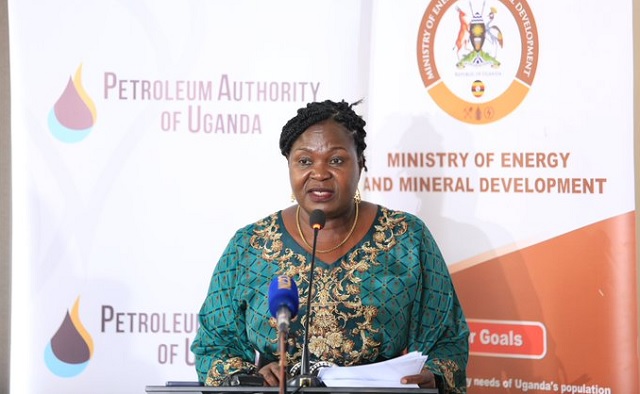
SPECIAL FEATURE | THE INDEPENDENT | Uganda is determined to exploit its oil and gas resources even with the challenges posed by the energy transition or Net Zero debate.
The determination by Uganda to tap into the black gold resources for development will be defended at the upcoming UN Climate Change Conference (COP28) by the Minister of Energy, Ruth Nankabirwa and Engineer Irene Bateebe, the Permanent Secretary.
Uganda has maintained that it needs oil revenue as an enabler for its Sustainable Energy for All (SEforALL) initiative at a time when there is a huge debate about the role of the oil and gas industry in the transition to net zero emissions.
Some have suggested that Uganda should not go ahead and invest more resources in oil and gas. They have warned that the projects will not be economically viable and will render some of the infrastructure being developed stranded.
There have been massive campaigns urging Uganda to stop those two projects that sit on an estimated 6.5 billion barrels of crude, of which about 1.4 billion barrels are currently considered recoverable.
In September 2022, the European Parliament passed an emergency resolution by a majority urging a halt of the projects including the East Africa Crude Oil Pipeline Project (EACOP) whose construction is expected to take off early next year.
Drilling starts
The drilling of production wells has been ongoing at the Kingfisher and Tilenga fields in Bulisa and Nwoya with production expected at the end of 2025.
The oil and gas activities especially the development of infrastructure worth over US$ 15 billion in the country before commencement of production, together with the expected annual revenues in excess of US$ 1 billion are beginning to significantly impact the country’s economy.
Oil production in the country is expected to peak at 230,000 barrels of oil per day. It is expected that the Tilenga and Kingfisher fields developments will generate up to USD 8 billion in fiscal revenues.
The government plans to develop a 60,000 barrels per day oil refinery at Kabaale Industrial Park, Hoima. Final Investment Decision for the refinery is expected this year with a view to commissioning the refinery in 2027.
Those developments have run into strong opposition from rights activists and environmental groups that say it threatens the livelihoods of tens of thousands of people and fragile ecosystems in the Albertine.
Uganda’s CO2 emissions from fuel combustion are estimated at 5.7 Mt CO2. Emissions from fuel combustion by sector: transport 66%; industry 22%; agriculture, forestry and fishing 10%; buildings 2%; electricity 1%.
Uganda has vehemently refused to abandon its oil and gas projects.
The government of Uganda sees oil development as a way to diversify energy supplies and improve energy security by cutting reliance on oil imports. It also hopes oil development will help reduce unsustainable biomass use by providing more LPG for cooking and help develop a petrochemical industry.
Those arguments are part of Uganda’s energy transition strategy to be launched in Dubai at the UN Climate Change Conference (COP28).
Uganda’s energy transition strategy
According to Eng. Irene Bateebe, Uganda’s objective in the energy transition strategy is to mitigate energy-related greenhouse gases as well as reduce the rate of deforestation due to the demand for biomass energy.
“For example, for petroleum, we are developing but we will also put them into decline in the long term,” said Bateebe. More countries, including Uganda have committed to net zero by 2050.
Put simply, net zero means cutting greenhouse gas emissions to as close to zero as possible, with any remaining emissions re-absorbed from the atmosphere by oceans and forests.
Science shows clearly that in order to avert the worst impacts of climate change and preserve a livable planet, global temperature increase needs to be limited to 1.5°C above pre-industrial levels.
Currently, the Earth is already about 1.1°C warmer than it was in the late 1800s, and emissions continue to rise. To keep global warming to no more than 1.5°C – as called for in the Paris Agreement – emissions need to be reduced by 45% by 2030 and reach net zero by 2050.
How does the government plan to achieve its net zero plans in energy?
According to Bateebe, the objectives of Uganda’s energy transition strategy have largely focused on planning for the energy system to support rapid economic development.
“Each time we are talking about the transition, we cannot hide away from the fact that a number of developing countries are energy-poor and they must be supported to advance and also develop economically,” she explained.
Oil and SDGs
Oil should enable Uganda to meet SDGs. So in the plan, Uganda seeks to articulate a realistic yet ambitious scenario for providing universal access to electricity and clean cooking as per the Social Development Agenda Seven (SDG7).
“So the key point is how we transit the 88% of the population that is using traditional biomass to our target by 2050 under this strategy of reducing it to 17 % but also increasing low-carbon fuel to 72%,” Bateebe told URN.
The difficult dilemma for Uganda is how to fund development if it abandons exploring newfound oil and gas resources due to climate change concerns.
Some studies and experts have argued that Uganda stands to lose out on its oil and gas resources because it will not be profitable as the world shifts away from oil.
Some have gone further to say that there shouldn’t be any effort to turn gas from the fields into Liquefied Natural Gas (LNG) yet some estimates indicate the small-scale LNG market will grow from USD 46.4 Billion (2023) to USD 92.8 billion in 2028.
In Uganda’s case, the deployment of cooking gas or LNG will be one of the technologies to meet the Sustainable Energy for All (SEforALL) Initiative.
SEforALL initiative
SEforALL is an initiative by the United Nations (UN) Secretary General towards the achievement of Sustainable Development Goal 7 (SDG7) – access to affordable, reliable, sustainable, and modern energy for all by 2030. Will Uganda’s Oil be economically viable?
Dr. Paul Bagabo, a consultant with the Natural Resource Governance Institute NRGI has over the years warned that the country should not invest in oil and gas because of the risks associated with the energy transition. Bagabo further argues that the cost of production of Uganda’s oil should fall so that Uganda produces oil a much lower level to meet the breakeven point for oil to be economically.
“We have the risks that as a country we shouldn’t invest much in the oil sector because of the falling demand that is necessitated by the energy transition” Bagabo advised.
However, government and lead investors like TotalEnergies insist that the Oil and gas market fundamentals indicate that a substantial amount of money will be invested in oil and gas.
According to TotalEnergies, in a commodity market, one needs to be sure about what people are going to buy. One of the key aspects of the energy market is the growth coming out of emerging markets from the global south. Five billion people today excluding China need much more energy to be lifted out of poverty.
Patrick Pouyanné, Chairman and Chief Executive Officer, TotalEnergies said, “We are guided by a balanced strategy. We have two pillars of oil and gas on one side, the energy of today where the demand continues to grow, and preparing for the future by developing a profitable large power development,”
Pouyanné explained that TotalEnergies has refocused its portfolio on fundamentals like low cost in order to deliver value and low emissions. “Because our first duty as an oil and gas producer is to slash down the greenhouse gas emissions throughout our operations.”
He said their strategy is fully compatible with a high level of profitability.
“We demonstrated that you can be strong in oil and gas and develop your energy transition strategy. While remaining profitable, “said Pouyanné
The company said it focuses on the most resilient oil projects, meaning those with a carbon intensity lower than its existing portfolio average and featuring the lowest breakeven points, below $25 per barrel.
An evaluation carried out in 2022 using the Petroleum Authority of Uganda’s Upstream Economic Model found that the total cost of developing and producing a barrel of crude oil in Uganda is about USD 17.73, excluding oil pipeline tariffs, which could be expected to add another USD 12.77/bb.
One of the reports by the International Energy Agency (IEA) indicated that demand for oil will grow through the decade.
TotalEnergies on the other hand estimated that 106 million barrels per day will be needed by 2028. Demand for oil reached an all-time high in June 2023 due to longtime drivers like the need for over five billion people in the global south to access energy to be lifted out of poverty.
The IEA projects that investments in oil and gas will total USD 800 billion this year. IEA said the current $800 billion invested annually in the global oil and gas sector could be halved by 2030 if a goal to limit global warming to 1.5 degrees Celsius is to be reached.
Energy is a vital need and TotalEnergies projects that 10 billion people will still need energy in 2050 for cooking, heating, lighting, and transportation.
*****
This is the second part of URN’s series/special coverage of Uganda’s energy transition debate. This part explains the energy transition in the context of Uganda’s oil and gas resources. Should Uganda’s oil remain in the ground? Will it be profitable?
 The Independent Uganda: You get the Truth we Pay the Price
The Independent Uganda: You get the Truth we Pay the Price


